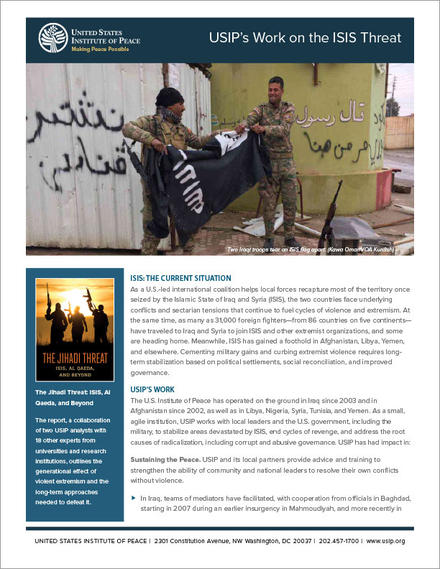 As a U.S.-led international coalition helps local forces recapture most of the territory once seized by the Islamic State of Iraq and Syria (ISIS), the two countries face underlying conflicts and sectarian tensions that continue to fuel cycles of violence and extremism. At the same time, as many as 31,000 foreign fighters—from 86 countries on five continents—have traveled to Iraq and Syria to join ISIS and other extremist organizations, and some are heading home. Meanwhile, ISIS has gained a foothold in Afghanistan, Libya, Yemen, and elsewhere. Cementing military gains and curbing extremist violence requires long-term stabilization based on political settlements, social reconciliation, and improved governance.
As a U.S.-led international coalition helps local forces recapture most of the territory once seized by the Islamic State of Iraq and Syria (ISIS), the two countries face underlying conflicts and sectarian tensions that continue to fuel cycles of violence and extremism. At the same time, as many as 31,000 foreign fighters—from 86 countries on five continents—have traveled to Iraq and Syria to join ISIS and other extremist organizations, and some are heading home. Meanwhile, ISIS has gained a foothold in Afghanistan, Libya, Yemen, and elsewhere. Cementing military gains and curbing extremist violence requires long-term stabilization based on political settlements, social reconciliation, and improved governance.
USIP's Work
The U.S. Institute of Peace has operated on the ground in Iraq since 2003 and in Afghanistan since 2002, as well as in Libya, Nigeria, Syria, Tunisia, and Yemen. As a small, agile institution, USIP works with local leaders and the U.S. government, including the military, to stabilize areas devastated by ISIS, end cycles of revenge, and address the root causes of radicalization, including corrupt and abusive governance. USIP has had impact in:
Sustaining the Peace. USIP and its local partners provide advice and training to strengthen the ability of community and national leaders to resolve their own conflicts without violence.
In Iraq, teams of mediators have facilitated, with cooperation from officials in Baghdad, starting in 2007 during an earlier insurgency in Mahmoudiyah, and more recently in Bartella, Tikrit, Yathrib, and Hawija. A 2015 agreement in Tikrit allowed more than 300,000 people to return to their homes, and the mediation methods developed are being applied elsewhere, including near Mosul.
/65.11717956250004,33.701800898491875,4/421x337.png?access_token=pk.eyJ1IjoiZGFsdG9ud2IiLCJhIjoiOWdSSXFQSSJ9.HZyjh4g3TAAOAncwelv9Vw)
/65.11717956250004,33.701800898491875,4/421x337.png?access_token=pk.eyJ1IjoiZGFsdG9ud2IiLCJhIjoiOWdSSXFQSSJ9.HZyjh4g3TAAOAncwelv9Vw)
















